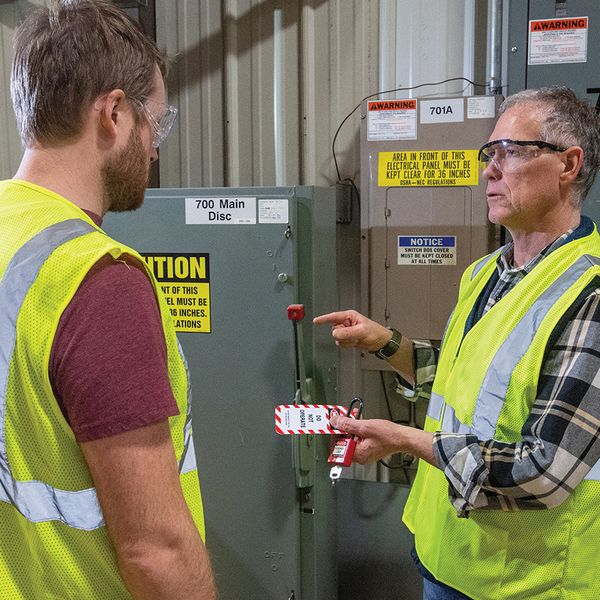LOTO in Construction Handout
Working on electrical circuits or equipment requires isolating sources of energy to prevent workers from getting injured from unexpected start up of equipment or stored energy that is released. Use lockout/tagout (LOTO) procedures for protection from these hazards.
In construction, some examples of working with electrical circuits or equipment that require using LOTO procedures include:
- HVAC systems,
- Construction equipment repairs,
- Temporary service drops, and
- Start-up and commissioning.
OSHA’s general industry LOTO standard, section 1910.147, doesn’t apply to construction work. Instead, 1926.417, Lockout and tagging of circuits, requires contractor’s workers to do these three things to isolate sources of electrical energy:
- Deactivate controls,
- Render de-energized equipment and circuit inoperable, and
- Place a control tag at all points of energization.
General Industry v. Construction
The word count difference between both industries’ LOTO requirements is about 5,000 words. Since construction workers don’t usually service and maintain equipment (like a service technician does), LOTO requirements aren’t as stringent in the construction industry.
Unlike the general industry’s LOTO standards, OSHA’s construction LOTO standards don’t apply only to service and maintenance activities. In a letter of interpretation, OSHA clarifies that LOTO should not be used to place machines or equipment out of service under general industry work.
Under construction rules, however, LOTO isn’t limited to just these two work activities.
Misuse of LOTO procedures cause the heightened awareness workers should have when they see LOTO devices to lose effect when used for other non-LOTO purposes. When workers see a LOTO device, they should clearly understand that an energy release or start-up hazard is present.
LOTO procedures
Most contractors use the LOTO procedures from 1910.147 and adopt its requirements as their company’s LOTO procedure. This practice has partly contributed to the misuse of LOTO procedures to place equipment and machines out of service.
LOTO is unnecessary when there isn’t an unexpected start up or stored energy hazard. A better practice is to follow standard operating procedures (SOPs) to render something out of service when such hazards aren’t present. Follow your company’s LOTO procedures and SOPs.
The utility transmission and distribution industries commonly use the three-step LOTO procedure above, but they apply to all sectors of construction work. Workers aren’t required to apply locks to isolate energy sources under 1926.417.
Instead, they can place control tags at points of energization and ensure circuits or equipment they’re working on are made inoperable by such means as:
- Pulling fuses or other circuit elements;
- Disabling plug-connected equipment; or
- Removing the battery from mobile equipment.
The last bullet above is an example where standard operating procedures may be sufficient in place of using LOTO procedures. Follow your jobsite’s safety program, though, which may require using its LOTO procedures while working on mobile equipment.
Group LOTO
Although not discussed explicitly in OSHA’s construction standards, group LOTO situations are common with work in the industry. Here are two safety tips to consider while using group LOTO procedures:
- Use group LOTO procedures while multiple workers have exposure to start up or the release of stored energy hazards, and
- Take responsibility to affix your LOTO device to the group lockbox or energy isolating device.
A common issue arises while working on jobsites with operating facilities. Group LOTO is often necessary to protect workers who are connecting new construction systems with existing facilities.




















































